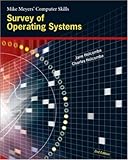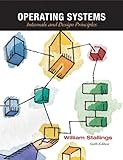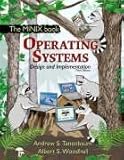|
|
Help |
| Home - Computer - Operating Systems (Books) | |
e99 Online Shopping Mall
|
|
Help |
| Home - Computer - Operating Systems (Books) | |
| 1-20 of 100 | Next 20 |
click price to see details click image to enlarge click link to go to the store
| 1. Operating System Concepts by Abraham Silberschatz, Peter B. Galvin, Greg Gagne | |
 | Hardcover: 992
Pages
(2008-07-28)
-- used & new: US$99.99 (price subject to change: see help) Asin: 0470128720 Average Customer Review: Canada | United Kingdom | Germany | France | Japan |
|
Editorial Review Product Description Open-source operating systems, virtual machines, and clustered computing are among the leading fields of operating systems and networking that are rapidly changing. With substantial revisions and organizational changes, Silberschatz, Galvin, and Gagne’s Operating System Concepts, Eighth Edition remains as current and relevant as ever, helping you master the fundamental concepts of operating systems while preparing yourself for today’s emerging developments. As in the past, the text brings you up to speed on core knowledge and skills, including: Beyond the basics, the Eight Edition sports substantive revisions and organizational changes that clue you in to such cutting-edge developments as open-source operating systems, multi-core processors, clustered computers, virtual machines, transactional memory, NUMA, Solaris 10 memory management, Sun’s ZFS file system, and more. New to this edition is the use of a simulator to dynamically demonstrate several operating system topics. Best of all, a greatly enhanced WileyPlus, a multitude of new problems and programming exercises, and other enhancements to this edition all work together to prepare you enter the world of operating systems with confidence. Customer Reviews (20)
| |
| 2. Modern Operating Systems (3rd Edition) by Andrew S. Tanenbaum | |
 | Hardcover: 1104
Pages
(2007-12-21)
list price: US$146.00 -- used & new: US$108.00 (price subject to change: see help) Asin: 0136006639 Average Customer Review: Canada | United Kingdom | Germany | France | Japan |
|
Editorial Review Product Description The widely anticipated revision of this worldwide best-seller incorporates the latest developments in operating systems technologies. The Third Edition includes up-to-date materials on relevant operating systems such as Linux, Windows, and embedded real-time and multimedia systems.Includes new and updated coverage of multimedia operating systems, multiprocessors, virtual machines, and antivirus software. Covers internal workings of Windows Vista (Ch. 11); unique even for current publications. Provides information on current research based Tanenbaum’s experiences as an operating systems researcher.A useful reference for programmers. What makes an operating system modern? According to author Andrew Tanenbaum, it is the awareness of high-demand computer applications--primarily in the areas of multimedia, parallel and distributed computing, and security. The development of faster and more advanced hardware has driven progress in software, including enhancements to the operating system. It is one thing to run an old operating system on current hardware, and another to effectively leverage current hardware to best serve modern software applications. If you don't believe it, install Windows 3.0 on a modern PC and try surfing the Internet or burning a CD. Readers familiar with Tanenbaum's previous text, Operating Systems, know the author is a great proponent of simple design and hands-on experimentation. His earlier book came bundled with the source code for an operating system called Minux, a simple variant of Unix and the platform used by Linus Torvalds to develop Linux. Although this book does not come with any source code, he illustrates many of his points with code fragments (C, usually with Unix system calls). The first half of Modern Operating Systems focuses on traditional operating systems concepts: processes, deadlocks, memory management, I/O, and file systems. There is nothing groundbreaking in these early chapters, but all topics are well covered, each including sections on current research and a set of student problems. It is enlightening to read Tanenbaum's explanations of the design decisions made by past operating systems gurus, including his view that additional research on the problem of deadlocks is impractical except for "keeping otherwise unemployed graph theorists off the streets." It is the second half of the book that differentiates itself from older operating systems texts. Here, each chapter describes an element of what constitutes a modern operating system--awareness of multimedia applications, multiple processors, computer networks, and a high level of security. The chapter on multimedia functionality focuses on such features as handling massive files and providing video-on-demand. Included in the discussion on multiprocessor platforms are clustered computers and distributed computing. Finally, the importance of security is discussed--a lively enumeration of the scores of ways operating systems can be vulnerable to attack, from password security to computer viruses and Internet worms. Included at the end of the book are case studies of two popular operating systems: Unix/Linux and Windows 2000. There is a bias toward the Unix/Linux approach, not surprising given the author's experience and academic bent, but this bias does not detract from Tanenbaum's analysis. Both operating systems are dissected, describing how each implements processes, file systems, memory management, and other operating system fundamentals. Tanenbaum's mantra is simple, accessible operating system design. Given that modern operating systems have extensive features, he is forced to reconcile physical size with simplicity. Toward this end, he makes frequent references to the Frederick Brooks classic The Mythical Man-Month for wisdom on managing large, complex software development projects. He finds both Windows 2000 and Unix/Linux guilty of being too complicated--with a particular skewering of Windows 2000 and its "mammoth Win32 API." A primary culprit is the attempt to make operating systems more "user-friendly," which Tanenbaum views as an excuse for bloated code. The solution is to have smart people, the smallest possible team, and well-defined interactions between various operating systems components. Future operating system design will benefit if the advice in this book is taken to heart. --Pete Ostenson Customer Reviews (32)
| |
| 3. Operating System Concepts, Seventh Edition by Abraham Silberschatz, Peter Baer Galvin, Greg Gagne | |
 | Hardcover: 921
Pages
(2004-12-14)
-- used & new: US$47.89 (price subject to change: see help) Asin: 0471694665 Average Customer Review: Canada | United Kingdom | Germany | France | Japan |
|
Editorial Review Product Description Customer Reviews (25)
| |
| 4. Schaum's Outline of Operating Systems by J. Archer Harris | |
 | Paperback: 256
Pages
(2001-10-23)
list price: US$19.95 -- used & new: US$10.37 (price subject to change: see help) Asin: 0071364358 Average Customer Review: Canada | United Kingdom | Germany | France | Japan |
|
Editorial Review Product Description Customer Reviews (4)
The last reviewer's comments seemed unwarranted especially since this book has more then enough problems on semaphores even if it's not as strong on file systems.This book is spot on covering the important parts of the classic operating systems curriculum from the sublime Tannebaum to the feckless Nutt.This book has an abundance of sample problems from all the major topics: File Systems, Interprocess communication, Device I/O, Networks, Security, and the dreaded Virtual Memory.Besides this the author covers algorithms, from the Philosophers to Bankers, from Hard drive c-scan to Paging LRU.I find the author easy to understand, complete, and very much in tune with what you will likely be tested on.I can honestly say this 200 page book was more valuable to me then the pescribed text.
I also would have have preferred a range of examples dealing with topics like semaphores and mutual exclusion, deadlock, file systems, but instead all the sample questions were disappointing and I found myself actually wasting time with this book.It would have been more productive to have just stuck with the textbook.Usually Schaum's does a good job, but I think they seriously fell short with their Operating Systems book. ... Read more | |
| 5. Operating System Concepts with Java by Abraham Silberschatz, Peter B. Galvin, Greg Gagne | |
 | Hardcover: 1040
Pages
(2009-11-09)
-- used & new: US$93.99 (price subject to change: see help) Asin: 047050949X Average Customer Review: Canada | United Kingdom | Germany | France | Japan |
|
Editorial Review Product Description Customer Reviews (5)
| |
| 6. Operating Systems In Depth: Design and Programming by Thomas W. Doeppner | |
 | Hardcover: 460
Pages
(2010-11-02)
-- used & new: US$102.20 (price subject to change: see help) Asin: 0471687235 Canada | United Kingdom | Germany | France | Japan |
|
Editorial Review Product Description | |
| 7. Guide to Parallel Operating Systems with WindowsXP and Linux by Ron Carswell, Heidi Webb, Terrill Freese | |
 | Paperback: 640
Pages
(2006-05-19)
list price: US$131.95 -- used & new: US$65.99 (price subject to change: see help) Asin: 1418837253 Average Customer Review: Canada | United Kingdom | Germany | France | Japan |
|
Editorial Review Product Description Customer Reviews (3)
| |
| 8. The Design of the UNIX Operating System [Prentice-Hall Software Series] by Maurice J. Bach | |
| Paperback: 486
Pages
(1986-06-06)
list price: US$80.00 -- used & new: US$36.66 (price subject to change: see help) Asin: 0132017997 Average Customer Review: Canada | United Kingdom | Germany | France | Japan | |
|
Editorial Review Product Description Customer Reviews (23)
| |
| 9. Operating Systems Concepts with Java by Abraham Silberschatz | |
 | Hardcover: 976
Pages
(2003-11-25)
list price: US$76.35 -- used & new: US$37.70 (price subject to change: see help) Asin: 0471452491 Average Customer Review: Canada | United Kingdom | Germany | France | Japan |
|
Editorial Review Product Description Customer Reviews (1)
| |
| 10. Survey of Operating Systems (Mike Meyers' Computer Skills) by Charles Holcombe, Jane Holcombe | |
 | Paperback: 704
Pages
(2005-03-21)
-- used & new: US$59.95 (price subject to change: see help) Asin: 0072257733 Average Customer Review: Canada | United Kingdom | Germany | France | Japan |
|
Editorial Review Product Description Customer Reviews (5)
The book starts off with a hardware overview, which is very helpful in the understanding of software. Then you deal with the older operating systems like Windows 3.X and DOS, this is a nice foundation to learn the roots of the operating system. Then comes NT, 2000, XP and there is even section for the MAC OS and Linux group. What I liked about this book was the exercises and labs; they would prove to very helpful in understanding certain concepts. About the only thing missing is cds with evaluation copies of the operating system(s), in case you don't have access to them. Overall this book is a great compliment to the Mike Meyers All in One A+ Study Guide. As an Instructor, this book becomes a valuable add on to the curriculum.
| |
| 11. Operating Systems: Internals and Design Principles (6th Edition) by William Stallings | |
 | Hardcover: 840
Pages
(2008-04-19)
list price: US$146.40 -- used & new: US$60.00 (price subject to change: see help) Asin: 0136006329 Average Customer Review: Canada | United Kingdom | Germany | France | Japan |
|
Editorial Review Product Description Serving as both a basic reference and an up-to-date survey of the state of the art, this book covers the concepts, structure, and mechanisms of operating systems. Stallings presents the nature and characteristics of modern-day operating systems clearly and completely. Updated treatment of Windows as a case study to cover Windows Vista. Online animations with references incorporated throughout. A new chapter on Embedded Operating Systems. Part Six (Distributed Systems and Security) moved online, reducing the cost and size of the book without loss of content. Expanded coverage of security. New figures added, with many existing figures updated to enhance clarity. A useful reference for programmers, systems engineers, network designers and others involved in the design of computer products, information system and computer system personnel. Customer Reviews (44)
| |
| 12. Operating Systems Design and Implementation (3rd Edition) by Andrew S Tanenbaum, Albert S Woodhull | |
 | Hardcover: 1080
Pages
(2006-01-14)
list price: US$146.00 -- used & new: US$74.99 (price subject to change: see help) Asin: 0131429388 Average Customer Review: Canada | United Kingdom | Germany | France | Japan |
|
Editorial Review Product Description Customer Reviews (30)
| |
| 13. Simple Real-time Operating System: A Kernel Inside View for a Beginner by Chowdary Venkateswara Penumuchu | |
 | Paperback: 322
Pages
(2007-08-06)
list price: US$30.50 -- used & new: US$26.49 (price subject to change: see help) Asin: 1425117821 Average Customer Review: Canada | United Kingdom | Germany | France | Japan |
|
Editorial Review Product Description Customer Reviews (8)
| |
| 14. The Integral Operating System: Version 1. 0 by Ken Wilber | |
 | Audio CD:
Pages
(2005-11-01)
list price: US$39.95 -- used & new: US$4.50 (price subject to change: see help) Asin: 1591793475 Average Customer Review: Canada | United Kingdom | Germany | France | Japan |
|
Editorial Review Product Description As one of the most influential figures of human spiritual evolution, Ken Wilber has been called "the Einstein of consciousness." For devoted fans and interested seekers alike, here is an unprecedented chance for you to "upload" Wilber’s teachings as he illuminates the intricacies of The Integral Operating System. Customer Reviews (7)
| |
| 15. Global Information Society: Operating Information Systems in a Dynamic Global Business Environment | |
 | Paperback: 305
Pages
(2005-04-30)
list price: US$69.95 -- used & new: US$85.99 (price subject to change: see help) Asin: 1591403073 Canada | United Kingdom | Germany | France | Japan |
|
Editorial Review Product Description | |
| 16. Learning the UNIX Operating System, Fifth Edition by Jerry Peek, Grace Todino-Gonguet, John Strang | |
 | Paperback: 174
Pages
(2002-01-15)
list price: US$19.95 -- used & new: US$9.55 (price subject to change: see help) Asin: 0596002610 Average Customer Review: Canada | United Kingdom | Germany | France | Japan |
|
Editorial Review Product Description Customer Reviews (44)
| |
| 17. Operating Systems: A Systematic View (6th Edition) by William S. Davis, T.M. Rajkumar | |
 | Paperback: 688
Pages
(2004-05-01)
list price: US$140.00 -- used & new: US$55.00 (price subject to change: see help) Asin: 0321267516 Average Customer Review: Canada | United Kingdom | Germany | France | Japan |
|
Editorial Review Product Description Customer Reviews (11)
| |
| 18. Operating Systems by Dhananjay Dhamdhere | |
 | Hardcover: 864
Pages
(2008-01-09)
-- used & new: US$69.16 (price subject to change: see help) Asin: 0072957697 Average Customer Review: Canada | United Kingdom | Germany | France | Japan |
|
Editorial Review Product Description Concepts, techniques, and case studies are well integrated so many design and implementation details look obvious to the student. Exceptionally clear explanations of concepts are offered, and coverage of both fundamentals and such cutting-edge material like encryption and security is included. The numerous case studies are tied firmly to real-world experiences with operating systems that students will likely encounter. Customer Reviews (1)
| |
| 19. Operating System Concepts by Abraham Silberschatz, Peter Baer Galvin | |
| Paperback: 48
Pages
(2001-10)
-- used & new: US$97.58 (price subject to change: see help) Asin: 0471418854 Average Customer Review: Canada | United Kingdom | Germany | France | Japan | |
|
Editorial Review Product Description This book is concerned with the design of operating systems, which is to say it enumerates the problems that pop up in the creation of efficient systems and explores alternative ways of dealing with them, detailing the advantages and shortcomings of each. For example, in their chapter on scheduling CPU activity, the authors explain several algorithms (first-come, first-served, and round-robin scheduling, among others) for allocating the capacity of single and multiple processors among jobs. They highlight the relative advantages of each, and explain how several real-life operating systems solve the problem. They then present the reader with exercises (this book is essentially a university textbook) that inspire thought and discussion. --David Wall Topics covered: The problems faced by designers of system software for electronic computers, and strategies that have been developed over the past 20 years to address (and, in some cases, solve) them. Problems of CPU scheduling, memory allocation, paging, processes and threads, storage management, distributed processes and storage mechanisms, and security are all discussed thoroughly and with many authoritative references. Customer Reviews (57)
| |
| 20. Distributed Operating Systems: Concepts and Design by Pradeep K. Sinha | |
 | Hardcover: 764
Pages
(1996-12-01)
list price: US$162.00 -- used & new: US$80.00 (price subject to change: see help) Asin: 0780311191 Average Customer Review: Canada | United Kingdom | Germany | France | Japan |
|
Editorial Review Product Description Customer Reviews (2)
What else I want? Great job!! I am looking forward for the second edition of this book! Bhanu Prasad
| |
| 1-20 of 100 | Next 20 |